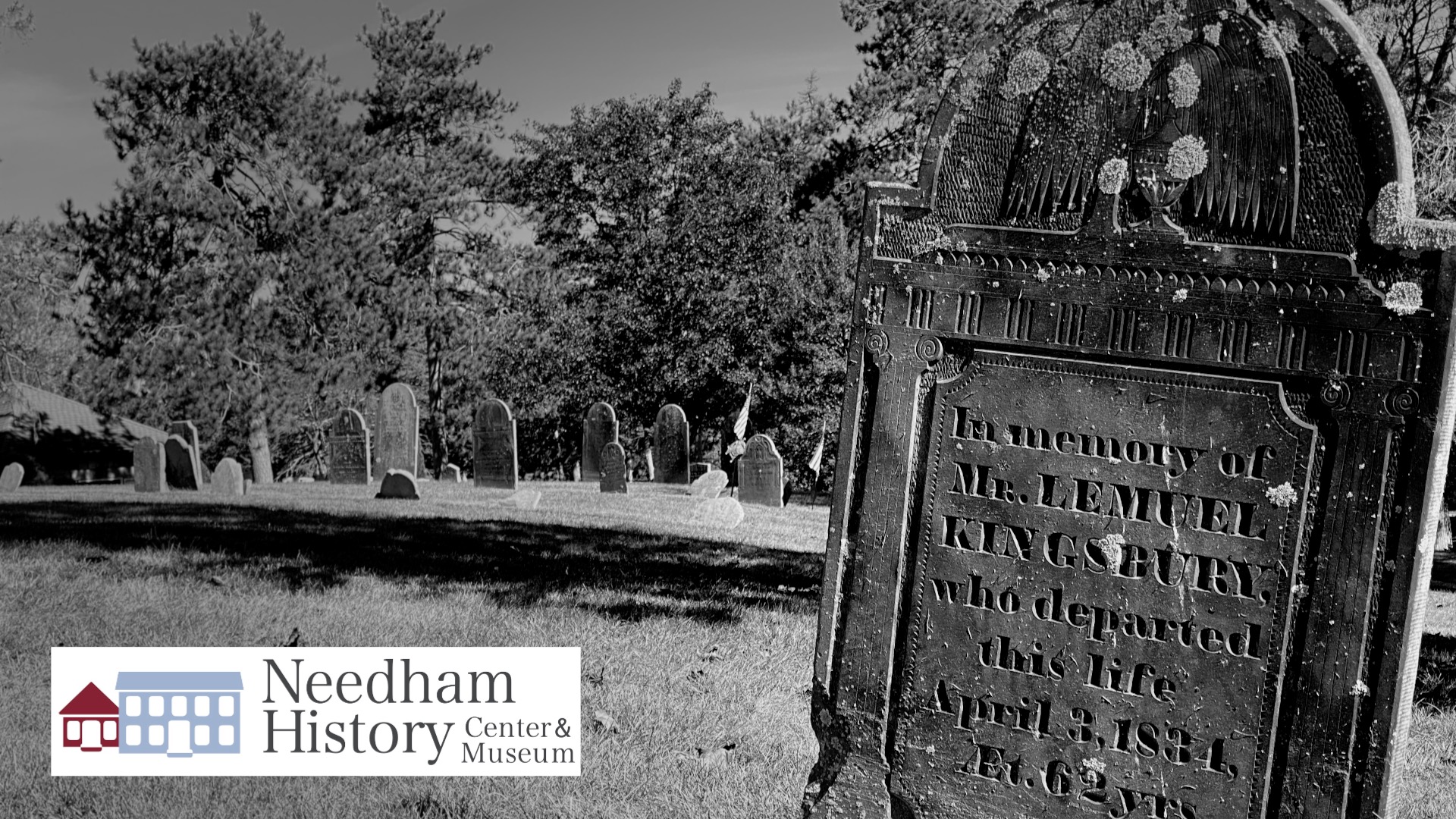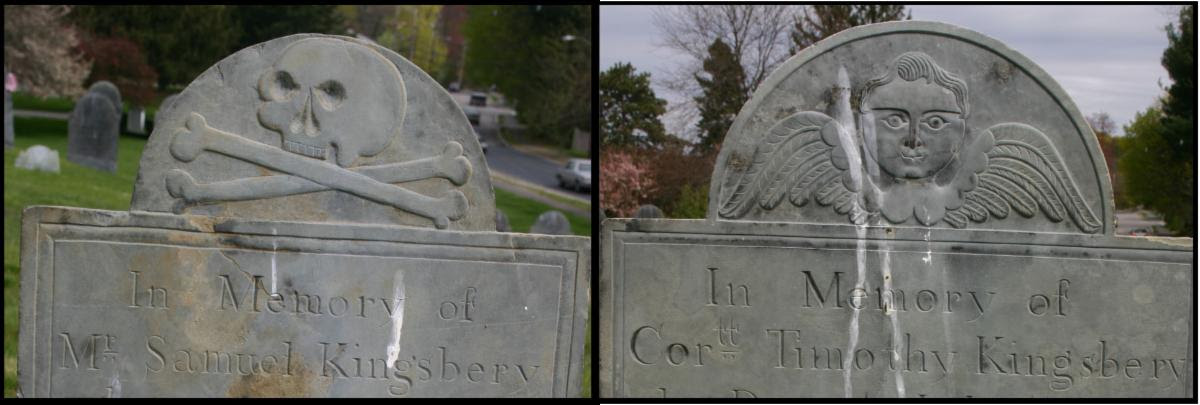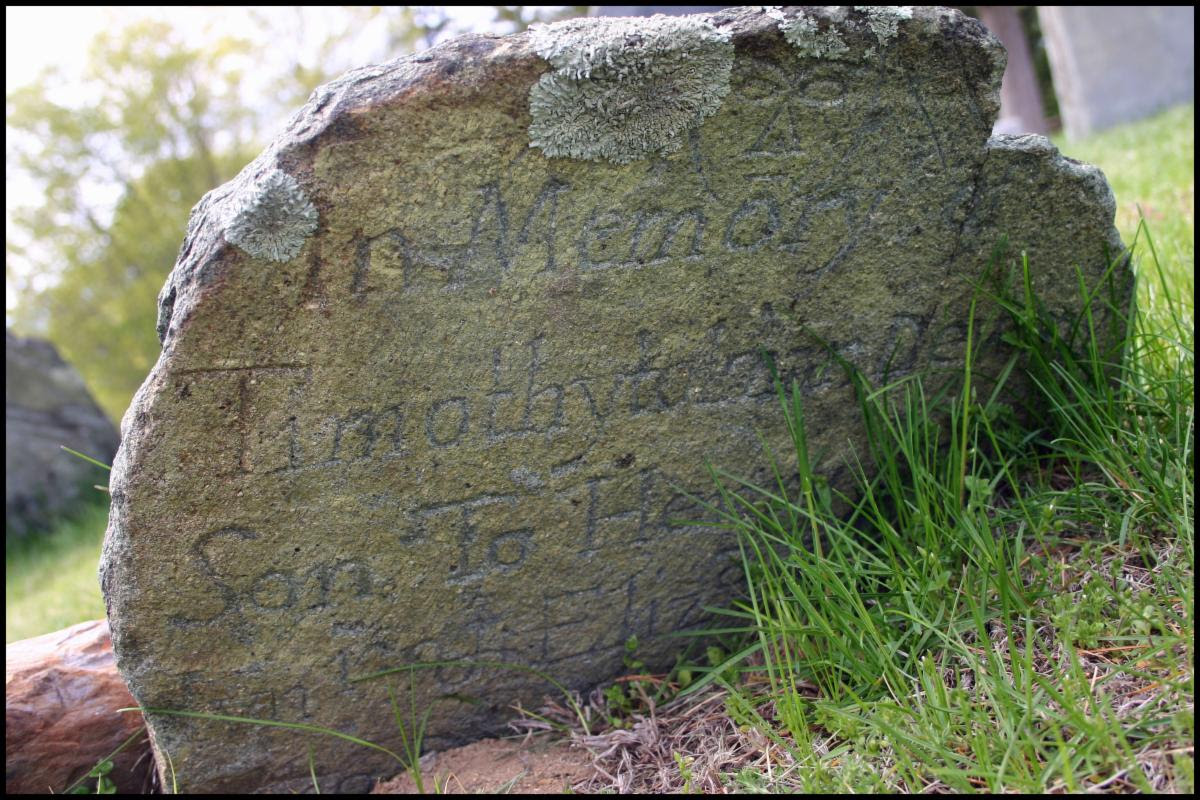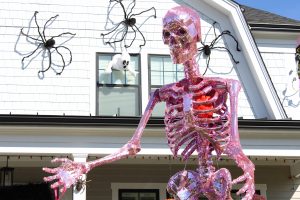
Needham History: So Sleep the Saints
No ghosts. No pirates. The cemetery is where people
lie quiet in the loving care that put them to rest.
 Gravestones carved by Henry Christian Geyer and his sons: (left to right) Samuel Kingsbury, who died in 1756 at the age of 18; Cornet Timothy Kingsbury, died 1778, age 76.
Gravestones carved by Henry Christian Geyer and his sons: (left to right) Samuel Kingsbury, who died in 1756 at the age of 18; Cornet Timothy Kingsbury, died 1778, age 76.
These are the Days of the Dead – Halloween/All Hallows’ Eve on October 31, All Saints’ Day on November 1, and All Souls’ on November 2.
For most of us, the holidays provide us with a good excuse to dress up and eat all the candy that we bought “for the kids.” But traditionally, and throughout the world, festivals like these are a time to confront our mortality and to keep safe in our hearts the memories of our beloved dead – to find comfort from both our fear and our grief by praying for them, talking to them, and sharing their stories for the next generation to remember.
This universal need to remember and be remembered can be seen in colonial America – Needham included – by the central location of cemeteries and churchyards. Although Nehoiden Street is by no means on the main path anymore, in 1711 when Needham was founded, it was right in the center of town, and on the town’s main street.
So, in the spirit (sorry!) of the Days of the Dead, here’s more about the Cemetery, and past Needhamites who are Gone, but Not Forgotten.
So Sleep the Saints
I love taking kids to the old Cemetery. I love watching their curiosity and enthusiasm overwhelm their initial nervousness at being in the presence of the Dead. They spread out from their defensive cluster to explore the stones, reading the names and trying to make sense of the words in the inscription. There is the occasional silent gathering as one of them figures out that the grave they are standing by holds a child younger than they are. Then they take off again, to peek down the gap behind a tilted stone in the hope/fear of seeing bones. And it inevitably happens – one of them wanders up to the top of the hill, where some of the oldest graves are, and comes tearing back shouting “A pirate! We found a pirate!”
Alas, I don’t have a pirate for them. I have a privateer’s wife, but that’s not nearly as exciting. But that is my opportunity to launch into my explanation of the images that they are seeing, and why they are included on the gravestones.
For Us, in our time, the words on a gravestone are the important information – who is it, when, how old, related to whom? Grave inscriptions are mini-biographies, and pack a large amount of information into just a few words. But for Them – people in the 18th century, as well as for modern third-graders – it was all about the pictures. It’s not that people couldn’t read – they could read as much as they needed to – but that most of their daily information was visual. The images on the gravestones, and the meanings that those images conveyed, were as familiar to them as the letters on the inscription are to us.
There is a whole sub-field of history dedicated to “Gravestone Studies” – understanding the imagery, the text, the changes over time, the identity of the stonecutter. Like all commercial goods, stone cutting was a market that varied in price, fashion, and demand. At the very plainest end are the home-made stones, such as that of little Timothy Dewing (1755, 14 months old); when found, they are most often the stones of young children and were probably made by a grieving but impecunious father. At the other end are the stones with elaborate decoration and personalized text, text that speaks to the actual person and not an abstraction, like the stone of Ebenezer Fisher (1798, age 77). In the vast middle are the pre-cut stones, not unlike the market today. The images and a suitable epitaph were already cut, just waiting for the purchaser to provide the name, dates, and age. Epitaphs fell into broad categories – Biblical verses (“I am the Resurrection and the Life”) or pious warnings (“Friend, reflect as you pass by / As you are now, so once was I”) that were suitable for anyone. But there were also verses that specifically spoke of youth taken far too soon: “This lovely child has took his flight / Who share’d a mother’s love and care…” (Charles Henry Skinner, 1824, age 7 years); “If youth and beauty joined could save… untenanted had been this grave…” (Charlotte Kingsbury, 1821, age 16). There were stones for the elderly who had lived a full life “In a full age, like a shock of corn / Cometh in his season” (George Fisher, 1845, age 80), or “Like a shock of corn, fully ripe” (John Burnham, 1869, age 71). These guys were farmers – they were comfortable with agricultural metaphors. Even Death was a Reaper.
So what about the Pirates? What the kids were finding is the skull-and-crossbones – a symbol of inevitable death just like the Jolly Roger, but with an entirely different context. The earliest gravestones are unsparingly candid about death – Death Triumphant. These folks knew that life was short and death could be sudden – you’d best be ready. The skull-and-crossbones were the image of You, Me, All of Us as we really are under all the finery. However you looked, whatever you owned, no matter what you did – in the end all you would leave behind on earth was your bare bones. These were the hard-core Puritans. In the first half of the 18th century, this was the dominant image.
The latter half of the 18th century was more hopeful – yes, you were Dust, but you were also Spirit, and after death your soul would take flight. This was depicted quite literally on gravestones as the 18th century progressed – the skull was still there, but now it had wings that symbolized the soul’s journey to God. This image rapidly morphed into the winged cherub – more emphasis on the Soul, and less on the mortality of the Body. The tables are turned, the Soul triumphs over Death.
The homemade gravestone in Memory of Timothy Tolman Dewing, son to Henry Jr and Elizabeth Dewing (1755, age 14 months). Although most stones were professionally made, some (usually those of young children) were home-made.
By the start of the 19th century, the discussion of death became more indirect, and the images on gravestones became more symbolic than literal – urns, willows, etc. Although more oblique, these were still meaningful to the people that used them:
Vines (usually down sides) – Renewal and Regrowth
Urn – to Dust you shall return
Willow (“Weeping”) – Sorrow, Grief
Archway – the Victory of Life over Death
Columns – the Support of Heaven
Rising Sun (Star) – Resurrection
Setting Sun – Death
Moon (usually crescent) – Renewal
Tree (growing upright) – Tree of Life
Hourglass – Time Flies (Life is Brief)
And who made these stones? As I mentioned above, some were home-made; but in New England, for the most part, they were made by professional stonecutters who would travel around the region. There are many whose names are known and whose work has been identified both by their distinctive styles, and by the surviving business records. The work of several important New England stonecutters has been identified in the Needham Cemetery.
The Geyer family – Henry Christian Geyer and his sons John Just Geyer and Henry Geyer Jr. were active from the mid- to late 1700s. The Geyer shop was in Boston, near the intersection of Washington and Essex Streets. The Geyer stones include a number of styles and images, probably reflecting the passing of time and the shifting of the business from father to sons. The Geyers were responsible for the most elegant of the skull-and-crossbones stones in Needham, as well as some of the later cherub stones. Their cherubs can be identified by their characteristic almond-shaped eyes. The finest stone in the Cemetery is a Henry Christian Geyer work – the elaborate stone of Mary Townsend, wife of the parish’s first Minister, Jonathan Townsend.
Daniel Hastings (1749-1803) – Daniel Hastings was based in Newton Corner, and more than 400 stones in MA and CT have been attributed to him. He was prosperous, and owned several parcels of land in Newton, was active in town affairs, and served in the militia during the Revolutionary War. Hastings earlier work is characterized by faces with strongly-shouldered wings; many of these faces are not cherubs at all, but little portraits of the deceased (this always makes me smile). The backs of his stones are rough-cut, and often have an “H” or “dh” monogram. Both “portrait” stones and H-monogram stones are present in the Needham Cemetery. Hastings’ later style has been described as the “low-brow” cherub – a round cherub face with a pronounced straight brow ridge. It is interesting that some families employed Hastings repeatedly, so their stones show both styles over time. It is not clear whether this change is a result of Hastings responding to a change in the market, or whether it shows the increasing involvement of his son/apprentice and others in his workshop.
Ebenzer Howard was Daniel Hastings’ brother-in-law. He moved into this area in 1760, and left for New Hampshire in 1770. In the meantime, he had a workshop in Newton Corner near Hastings, and they may have done some work together. Howard’s work in Needham dates to the 1760s. His cherubs are characterized by their luxuriant wings, curly hair, and wide almond-shaped eyes. Most of the known Howard stones in Needham were made for the Daniell family.
There are numerous other stones, with a variety of designs, and by artists who have not been identified. The kids look for the different designs. They ask me quietly why the Morton family has seven small stones in a row. They ask me how I KNOW there aren’t really any pirates. Ultimately, they will ask me about ghosts. Are there any ghosts in the cemetery? Have I seen them? No, I tell them. To me, the cemetery is the place where people lie quiet; and the rows of stones – whether made by amateur and grieving hands or by professional artists – speak of the loving care that put them to rest.
“So sleep the saints, and cease to groan,
When sin and death have done their worst…”
Gravestones carved by Daniel Hastings: (left to right) Lt. John Bowen of Roxbury, who died in Needham in 1775 at the age of 38; Sarah Kingsbury, died 1784, age 23.
 |
Gloria Polizzotti Greis is the Executive Director of the Needham History Center & Museum. For more information, please see their website at www.needhamhistory.org. |

